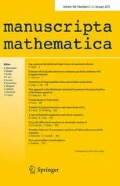Abstract
We show that the existence of a sequence of elements from cocompact torsion-free arithmetic subgroups ofSL(2,R) converging to the identity is equivalent to the density of Salem numbers in [1,∞).
Similar content being viewed by others
References
D.W. Boyd, Small Salem numbers, Duke Math. J., Vol. 44, 315–328 (1977)
D.A. Kazhdan-G.A. Margulis, A proof of Selberg’s hypothesis, Math. Sbornik 75, 162–168 (1968)
D.H. Lehmer, Factorisation of certain cyclotomic functions, Ann. of Math. 34, 461–479 (1933)
R. Salem, Algebraic numbers and Fourier analysis, Heath Math. Monographs, 1963
W. Thurston, The geometry and topology of 3-manifolds, Mimeographed notes, Princeton University, Princeton, 1977
M-F Vigneras, Arithmetique des algebres de quaternions, Springer-Verlag, 1980
Author information
Authors and Affiliations
Rights and permissions
About this article
Cite this article
Sury, B. Arithmetic groups and Salem numbers. Manuscripta Math 75, 97–102 (1992). https://doi.org/10.1007/BF02567074
Received:
Revised:
Issue Date:
DOI: https://doi.org/10.1007/BF02567074


